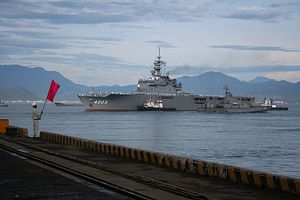Earlier this month, Japan’s defense chief paid a visit to Vietnam. While the interaction was just one of several scheduled engagements between the two sides, it nonetheless spotlighted some of the ongoing activity in the naval aspect of their defense relationship.
As I have observed previously in these pages, Japan and Vietnam have been developing the defense component of their wider extensive strategic partnership over the past few years, with Vietnam looking to strengthen ties with a range of powers as part of its omnidirectional foreign policy and Japan seeking to boost relations with Southeast Asian countries, including in the defense domain.
This has included the maritime domain as well. Recent gains have included not just headline items such as periodic maritime security assistance tied to China’s assertiveness in the East China Sea and the South China Sea, but also new naval drills, an agreement on coast guard cooperation, and discussions on more defense equipment transfers, some of which have been folded into broader documents such as the Joint Vision Statement on Defense Cooperation signed by the two defense ministries in April 2018.
Earlier this month, the defense aspect of the relationship was in the headlines again with the visit of a top Japanese defense official to Vietnam. Koji Yamazaki, the chief of the joint staff of the Japan Self-Defense Forces, was on an official visit to Vietnam from March 1 to March 4 at the invitation of the chief of the general staff of the Vietnam People’s Army.
Yamazaki’s visit consisted of a series of interactions. He and his delegation met with a series of Vietnamese officials including Ngo Xuan Lich, the defense minister, as well as Phan Van Giang, the chief of the general staff of the VPA and the deputy minister of national defense. He also had visits to the 249 Brigade under the High Command of Combat Engineers and the 147 Brigade under the Naval Command.
Per the official account of the interaction by Vietnam’s defense ministry, during the meeting between Giang and Yamazaki, which occurred on March 2 at the headquarters of Vietnam’s defense ministry, the two sides took stock of the momentum in the defense aspect of the extensive strategic partnership between them as well as the cooperation between the VPA and the JSDF. They also agreed to continue collaboration in various areas, including training, IT, disaster mitigation, humanitarian relief, U.N. peacekeeping operations, military medicine and the defense industry, and support for each other at multilateral forums.
In terms of newer areas of cooperation, shipbuilding was a focus of media reports that followed the interaction. Vietnamese media outlets noted that Japan had agreed to provide Vietnam technologies for building military ships, among other areas of agreement including more visits by Japanese ships and aircraft and training in areas including diving, medical, and rescue equipment to the Vietnamese navy.
Defense outlet IHS Jane’s noted that the collaboration came in the form of a new agreement on naval shipbuilding that constitutes an extension of the defense pact inked in 2018 to “implement a cooperation project in the field of shipbuilding [and] technology transfers in military shipbuilding.” It added that the new agreement facilitates Japanese support to Vietnam in “defense industrial technical training” and sharing defense industry “expertise and experiences” as well as other areas including Tokyo providing scholarships for Vietnamese students in military engineering and high technologies; joint training activities between the two countries’ military-technical academies; and language courses for each side’s technicians and engineers.
Unsurprisingly, not much in the way of specifics was disclosed by either side. Nonetheless, as headline-grabbing developments continue take place in the coming months, this aspect of their defense cooperation will be important to watch in the future amid wider domestic and regional developments.
































